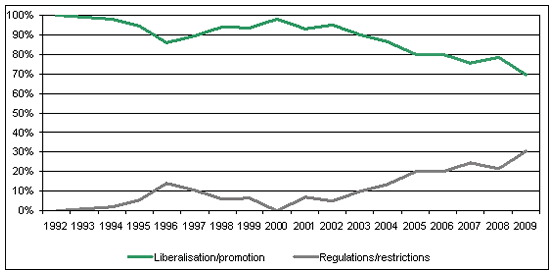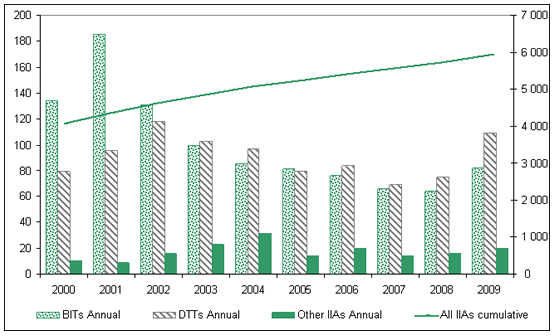| EMBARGO The contents of this press release and the related Report must not be quoted or summarized in the print, broadcast or electronic media before 22 July 2010,17:00 [GMT] (13:00 New York; 19:00 Geneva, 22:30 New Delhi, 02:00 - 23 July 2010 Tokyo) |
Striking a balance is aim as countries want growth but also security in wake of global financial crisis, UNCTAD report says
Geneva, 22 July 2010 - Government measures related to foreign direct investment (FDI) are trying to address the lessons taught by the global financial crisis at the same time as they seek to spur incoming FDI to help with recovery from the downturn, UNCTAD´s World Investment Report 2010(1) (WIR) says.
Efforts to liberalize FDI inflows while regulating them more thoroughly are posing a challenge for governments and international policymakers, the report notes. The dichotomy contrasts with clearer trends towards liberalization observed in the 1990s and the early years of the 21st century.
The WIR 10, released today, is subtitled "Investing in a Low-carbon Economy".
National policies continue to liberalize and promote foreign investment, but also regulate more
In 2009, most countries continued to liberalize, promote, and ease the course of foreign investment. A little less than 70% of the reported measures initiated last year supported the liberalization and promotion of foreign investment. However, the share of more restrictive policy measures observed in 2009, at 30%, was the highest since the WIR began reporting on the subject in 1992 (figure 1). The WIR 2010 identifies a total of 102 investment policy measures taken in 2009, of which 71 supported the liberalization and promotion of foreign investment, and 31 tended towards tighter regulations for FDI.
Apart from these measures, economic stimulus programmes and rescue packages implemented in response to the crisis were a defining characteristic of investment-related policy developments in 2009. Today, there are questions on how to best phase out such State aid, and care needs to be taken that exit strategies do not result in investment protectionism.
Number of international investment agreements continues to expand, and there is increasing interaction with other policy areas
The global network of international investment agreements (IIAs) - comprising bilateral investment treaties (BITs), double taxation treaties (DTTs) and other IIAs - continued to expand in 2009 to reach a total of 5,939 agreements (figure 2). Among the 211 new agreements concluded in 2009 were 82 BITs, 109 DTTs and 20 other IIAs, The growing number of these agreements suggests that countries continue to use them as a means of attracting and promoting foreign investment. In keeping with the rising number of IIAs, the number of investor-State dispute settlement cases filed under IIA provisions increased by at least 32. That brought the total to at least 357 cases.
IIAs also continue to follow a trend towards greater detail and sophistication. There are growing links between investment and other policy concerns, such as financial systems reform, environmental protection, and climate change. At the same time, there is a trend towards consolidation, in which regional IIAs increasingly complement bilateral arrangements. Developments in 2009 suggest that IIAs are evolving towards a more integrated, inclusive, and elaborate approach, characterized by a re-balancing of rights and obligations between investors and host countries. Making IIAs effectively work for development remains a challenge, however.
New initiatives to deal with global challenges
In addition, international policy initiatives that were launched to deal with global crises have implications for international investment. Examples include efforts to establish international principles for responsible investments in agriculture, spearheaded by UNCTAD, the Food and Agriculture Organization, the International Fund for Agricultural Development and the World Bank Group. G20 members have committed to refraining from protectionism in the trade and investment area and have asked intergovernmental organizations, including UNCTAD, to monitor and publicly report on this issue. Moreover, efforts to reform the financial system and address the weaknesses that underpinned the global financial crisis are under way. Here, attention needs to be given to the coherence between the emerging international financial system and the international investment system, as both govern short- and long-term cross-border capital flows.
After the crisis, numerous challenges for investment policymaking
As countries strive to overcome the recent financial, economic, energy, food, and climate crises, designing investment policies to harness foreign investment for economic growth and development is more important - but also more difficult - than ever, the WIR says. There is a need to address effectively the interaction between investment and broader economic, social, and environmental issues - and to develop coherent and mutually supportive approaches. Out of a variety of available tools, policymakers need to identify the best mix. A key challenge is to strike a proper balance between investment promotion and regulation. And national and international initiatives must be in line with countries´ specific economic and development concerns. The report says that UNCTAD, with its global membership and its focus that combines research and policy advice, can play an important role in helping governments set up effective investment regimes.
The World Investment Report and its database are available online at http://www.unctad.org/wir and http://www.unctad.org/fdistatistics and http://www.unctad.org/diae |
ANNEX
Tables and figures
Figure 1: National policy changes, 1992-2009 - (per cent)
Source:UNCTAD, World Investment Report 2010, Investing in a Low-carbon Economy, Figure III.1.
Figure 2. Trends of BITs, DTTs and IIAs, 2000-2009
Source: UNCTAD, based on IIA database.


